Marco Cadioli, con il suo nuovo progetto espositivo intitolato “Back to the Metaverse”, inaugura il terzo anno di programmazione di SMDOT/Contemporary Art nella città di Udine. In questo caso, sia Marco che il sottoscritto, abbiamo deciso di affrontare e descrivere ciò che ci sta “sotto il naso”, facendo attenzione di non “andarci a sbattere”, prendendo coscienza, se ce ne fosse ancora bisogno, come la posizione stessa del contemporaneo, che affrontiamo da anni, probabilmente sia la più svantaggiosa rispetto a qualunque tipo di arte, che si tratti di scrittura, musica, lavori visivi, teatro, cinema. Essere troppo vicini, attratti dalla forza della “the next big think”, spinti dal timore di essere tagliati fuori da ciò che sta per diventare grande, rilevante, redditizio, è sicuramente un rischio, ma sostenuti dalla nostra curiosità e voglia di reincanto, siamo saliti sulle spalle del fantasma di Charles Baudelaire e del suo “Il pittore della vita moderna”, dove l’artista è “l’uomo
che comprende il mondo e le ragioni misteriose e legittime di tutte le sue usanze”,
ed abbiamo deciso di metterci scomodi e di entrare nel metaverso. Un
viaggio iniziato qualche anno fa e oggi diventato argomento di grandissimo
interesse ed attenzione. La mostra è il pretesto per affrontare nuove parole, concetti e
figurazioni, approfittando della sensibilità, attenzione e capacità di analisi che Marco
Cadioli ha sempre avuto per tutto ciò che accade al di là dei nostri schermi e soprattutto a
come questo si materializza nelle nostre abitudini quotidiane.
Lo spazio della galleria diventa un’oasi di senso, una soglia di riflessione, ma anche un
luogo da abitare da cui andare e ritornare, un luogo presente, tra passato e futuro,
lasciando punti di ancoraggio e cercando una verità complessa sempre in movimento tra
luce ed oscurità.
Metaverso, web 2.0 e web 3.0, realtà virtuale, realtà aumentata, blockchain, Nft, criptoarte,
criptovalute, questi sono alcuni dei nuovi elementi che costruiscono una parte del piano
concettuale sul quale è edificata la mostra e con i quali gli spettatori e le opere esposte si
misurano. Per chi non abbia la minima idea di cosa stiamo parlando, il vivo consiglio è
di approfittare di questo evento per informarsi, perché questo è il futuro, anzi il presente,
con il quale bisogna confrontarsi. Finanza, società, politica, arte, abitudini
quotidiane sono in continuo cambiamento, l’avanzare di nuove applicazioni tecnologiche e
la crisi economica in corso sono due vettori che stanno imprimendo una grande
accelerazione all’interno di un’ambiente ecologico molto fragile.
La parola Metaverso è un termine coniato da Neal Stephenson, appare la prima volta nel suo romanzo di fantascienza cyberpunk “Snow Crash” del 1992, siamo in una sorta di realtà virtuale condivisa attraverso internet e si è rappresentati in tre dimensioni dal proprio avatar. Possiamo dire che questo romanzo anticipa di alcuni anni la nascita del primo mondo virtuale, grazie alla costruzione di una piattaforma informatica denominata Second Life che viene lanciata nel 2003. Negli stessi anni assistiamo all’evoluzione del web 1.0 verso il web 2.0, termine coniato tra il 2004 e il 2005. Da un’attività di interconnessione basata su reti di comunicazione si passa ad uno scambio e produzione di informazioni e contenuti tra gli utenti. Interazione, condivisione e partecipazione sono gli elementi fondanti del web 2.0. Eccoci giunti al web 3.0 difficile da descrivere perché è un processo ancora in fase di definizione. Gli elementi caratteristici sembrano essere la trasformazione del web in un grandissimo database, un maggiore sfruttamento dell’intelligenza artificiale, l’evoluzione verso un web semantico, la creazione di un web potenziato, cioè in grado di influenzare la realtà come non era mai accaduto, la costruzione di ambienti 3D. Il Metaverso è un prodotto del web 3.0. Stessa cosa possiamo dire per la blockchain, un registro digitale estremamente sicuro, che ha permesso la realizzazione delle criptovalute e dei famosi Nft (non fungible token), un certificato di unicità e proprietà di un file digitale.
“Back to the Metaverse” è l’inizio di una riflessione, di una pratica su questi temi.
“Enter the Metaverse (the whirlpool and the promise)” è un’installazione site specific, creata per lo spazio espositivo, costituita da due video con audio, due stampe digitali montate su D-bond e una serie di stampe sagomate su carta adesiva posizionate direttamente sulla parete. Figurazione e concetto si intersecano grazie anche allo sguardo del guardante attratti da un “gorgo” e da una “promessa”. Siamo davanti alla figurazione di una tecnologia che mi vuole bene, che non mi fa sentire freddo e fame, che mi porta via dalla realtà che non mi piace. Corpi digitali (avatar), attratti da una terra promessa, dove tutto è decentralizzato e finanziarizzato. Una tecnologia che diventa una possibilità di scappare dalla complessità, dal corpo fisico, che produce quotidianamente attrito, dolore, sofferenza, orrore, paura, ma anche fascino, gioia, meraviglia, incanto. La promessa di un nuovo mondo, di nuovi mondi che in relazione alla nostra attuale quotidianità, almeno in questo momento, perdono 2 a 5. La vista e l’udito sono molto sollecitati, probabilmente solo parzialmente, ma gli altri sensi vengono abbandonati quasi totalmente.
La realizzazione di una Nft collection, denominata, Marco Manray (Marco Cadioli),“Entering the Metaverse, entering the cryptocurrency market, being sucked into a whirlpool”, visitabile solo online, inquadrando un codice qr, fa parte di questo esercizio artistico con l’obiettivo di acquisire conoscenza e consapevolezza degli strumenti e di come questi influenzino i nostri modi di vivere, il nostro pensiero. Il confronto con le altre opere in mostra crea un ambiente scomodo, vitale, in tensione, tra la caduta / attrazione senza attrito e la possibilità di mantenere un controllo, una distanza, necessaria alla consapevolezza di abitare un corpo. “Me Flying over the birth of a virtual world”
“Der Neue Wanderer”, “Rousseau Reloaded series”, stampe digitali di lavori realizzati tra il 2006 e il 2008 frequentando ed esplorando Second Life mostrano un atteggiamento, un sentimento nei confronti di questo nuovo mondo completamento differente da quello di oggi. Lo sguardo in “Me Flying over the birth of a virtual world” è dall’alto, la tecnologia supporta uno dei più grandi sogni dell’uomo, volare, l’occhio è distante, verso uno spazio vuoto, tutto da scoprire e costruire, stessa cosa accade in “Der Neue Wanderer”, dove è facile individuare un riferimento al quadro “Il viandante sul mare di nebbia” di Caspar David Friedrich, pittore dell’Ottocento, questo nuovo viandante si affaccia nel Metaverso, mantenendo lo sgomento e il piacere di essere davanti a qualcosa di grande e sconosciuto. Nella serie di tre lavori “Rousseau Reloaded series”, appropriandosi dei colori e dei paesaggi del pittore francese, mostra sempre questo nuovo mondo come un mondo delle origini incontaminato, riferendosi alla pittura dell’Ottocento, documentando, nello stesso tempo, un servizio fotografico con una modella per una rivista di moda.
Nel lavoro di Marco non c’è il timore o il rifiuto del Metaverso e del web 3.0, sarebbe come temere il demonio o le streghe, tanto meno una critica fine a sé stessa, piuttosto si manifesta un invito al mondo dell’arte a mettere in discussione i valori tecno culturali che possono essere creati ed espressi appropriandosi ed utilizzando questi strumenti. Grazie
alle pratiche artistiche possiamo andare e tornare dal futuro, possiamo documentarlo e osservarlo, possiamo provare a modificare il presente per costruirci un presente e un futuro migliore, avendo sullo sfondo il pensiero dello scultore americano Walter De Maria, “Sia l’arte che la vita sono una questione di vita e di morte”.
Stefano Monti
Marco Cadioli’s new exhibition project “Back to the Metaverse”, inaugurates the third year of exhibitions at SMDOT / Contemporary Art in the city of Udine. This time, both Marco and I decided to tackle and describe something that is “right under our noses”, determined not to “stumble over it”. We have been dealing with contemporary art for many years, and it hardly needs be said that we realise that contemporary art finds itself at a great disadvantage compared to any other type of art, be it writing, music, visual art, theatre or cinema. It can certainly be risky to be too close, attracted by the power of “the next big thing”, driven by the fear of being cut off from what is about to become huge, relevant or profitable. However, supported by our curiosity and desire for re-enchantment, we stood on the shoulders of the ghost of Charles Baudelaire and his work “The Painter of Modern Life”, where the artist is “a man who understands the world and the mysterious and legitimate reasons behind all its customs”. We decided to make ourselves uncomfortable and enter the metaverse. This is a journey that began a few years ago and has now become a matter of great interest and attention.
The exhibition is the pretext to tackle new words, concepts and figurations, taking advantage of Marco Cadioli’s sensitivity, his attention and the analytical skills he has always had for everything that happens beyond our screens, and in particular for the way these materialize in our daily routines.
The gallery space becomes an oasis of meaning, a threshold for reflection, but also a
place to inhabit, one from which to go and return, a place in the present, between the past and the future, leaving anchor points and looking for a complex truth that is always shifting between light and darkness.
Metaverse, web 2,0 and web 3,0, virtual reality, augmented reality, blockchain, Nft, crypto-art, cryptocurrencies: these are just some of the new elements that underlie the
conceptual project this exhibition is built on, and with which the viewers and the works will deal with. For those who don’t have the slightest idea what we are talking about, we warmly invite you to take the opportunity provided by this event to learn about these things, because this is the future, or rather the present, that we must confront. Finance, society, politics, art and daily habits are constantly changing. The advancements of new technological applications and the current economic crisis are two factors that are having a significant impact on a very fragile ecological environment.
The word Metaverse is a term coined by Neal Stephenson. It appeared for the first time in his 1992 cyberpunk science-fiction novel “Snow Crash”, where there was a kind of internet-based shared virtual reality, and people were represented in 3D by an avatar. We can say that this novel anticipated the birth of the first virtual world by a few years, as the IT platform ‘Second Life’ was not launched until 2003. In the same period we witnessed the evolution of web 1.0 towards web 2.0, a term coined between 2004 and 2005. From interconnectivity based on communication networks, we moved to the exchange and production of information and content between users. Interaction, sharing and participation were the fundamental elements of web 2.0.
Now we have come to web 3.0, which is difficult to describe because its process is still being defined. The transformation of the web into a huge database, a greater exploitation of artificial intelligence, the evolution towards a semantic web, the creation of an enhanced web – capable of influencing reality as it had never done before- and the construction of 3D environments seem to be its characterising elements. The Metaverse is a product of web 3.0. We can say the same about blockchain, an extremely secure digital record, which has allowed the creation of cryptocurrencies and the famous Nft (non-fungible tokens), a certificate of uniqueness and ownership of a digital file.
“Back to the Metaverse” is the beginning of a reflection, a practice that explores these issues. “Enter the Metaverse (the whirlpool and the promise)” is a site-specific installation created for the exhibition space. It consists of two videos with audio, two digital prints mounted on D-bond and a series of shaped prints on adhesive paper placed directly on the wall. Figuration and concept intersect through the gaze of the viewer, attracted by a “whirlpool” and a “promise”. What we are seeing is the figuration of a technology that loves us, that doesn’t make us feel cold and hungry, but takes us away from a reality that we don’t like. Digital bodies (avatars) are attracted to a promised land, where everything is decentralized and financialised. A technology that becomes a possibility to escape from the complexity, and from the physical body, which produces daily friction, pain, suffering, horror and fear – but also charm, joy, wonder and enchantment. The promise is of a new world, but a new world that – at least for now – is losing 2-5: in it sight and hearing are certainly stimulated (although probably only partially) but the other senses are almost totally abandoned.
Part of this artistic exercise is the creation of an Nft collection, named Marco Manray (Marco Cadioli), “Entering the Metaverse, entering the cryptocurrency market, being sucked into a whirlpool”. This is only accessible online using a QR code. The aim is that of acquiring knowledge and awareness of the tools and how they influence our ways of living and thinking. The comparison with the other works on display creates an uncomfortable environment, vital and full of tension. Something between falling/attraction without friction and the possibility of maintaining control, a distance, necessary for the awareness of inhabiting a body. “Me Flying over the birth of a virtual world”, “Der Neue Wanderer” and “Rousseau Reloaded series”, are digital prints of works made between 2006 and 2008 by frequenting and exploring Second Life. These works display an attitude, a feeling towards this new world which is completely different from the current one. The gaze in “Me Flying over the birth of a virtual world” is a bird’s eye view: technology supports one of the greatest dreams for humanity, that of flying. The eye is distant, it looks towards an empty space, one to be discovered and built. The same is true for: “Der Neue Wanderer”, where it is easy to spot a reference to the painting “The Wanderer Above the Sea of Fog” by the 19th century painter Caspar David Friedrich. This new wanderer appears in the Metaverse, maintaining the dismay and the pleasure of standing before something great and unknown. In the three-piece “Rousseau Reloaded series”, appropriating the colours and landscapes of the French painter, Marco once again shows this new world as an uncontaminated land of origins. This refers to 19th century painting, at the same time documenting a photo shoot with a model for a fashion magazine.
In Marco’s work there is no fear or rejection of the Metaverse and web 3.0 – it would be like being afraid of the devil or witches – much less is there criticism for criticism’s sake. Rather this invitation to the world of art is manifested so as to question the techno-cultural values that can be created and expressed by appropriating and using these tools. Thanks to artistic practices we can visit the future and come back from it, we can document and observe it, we can try to modify the present to build a better present and future, and in the back of our minds we remember the words of American sculptor Walter De Maria: “both art and life are a matter of life and death”.
Stefano Monti
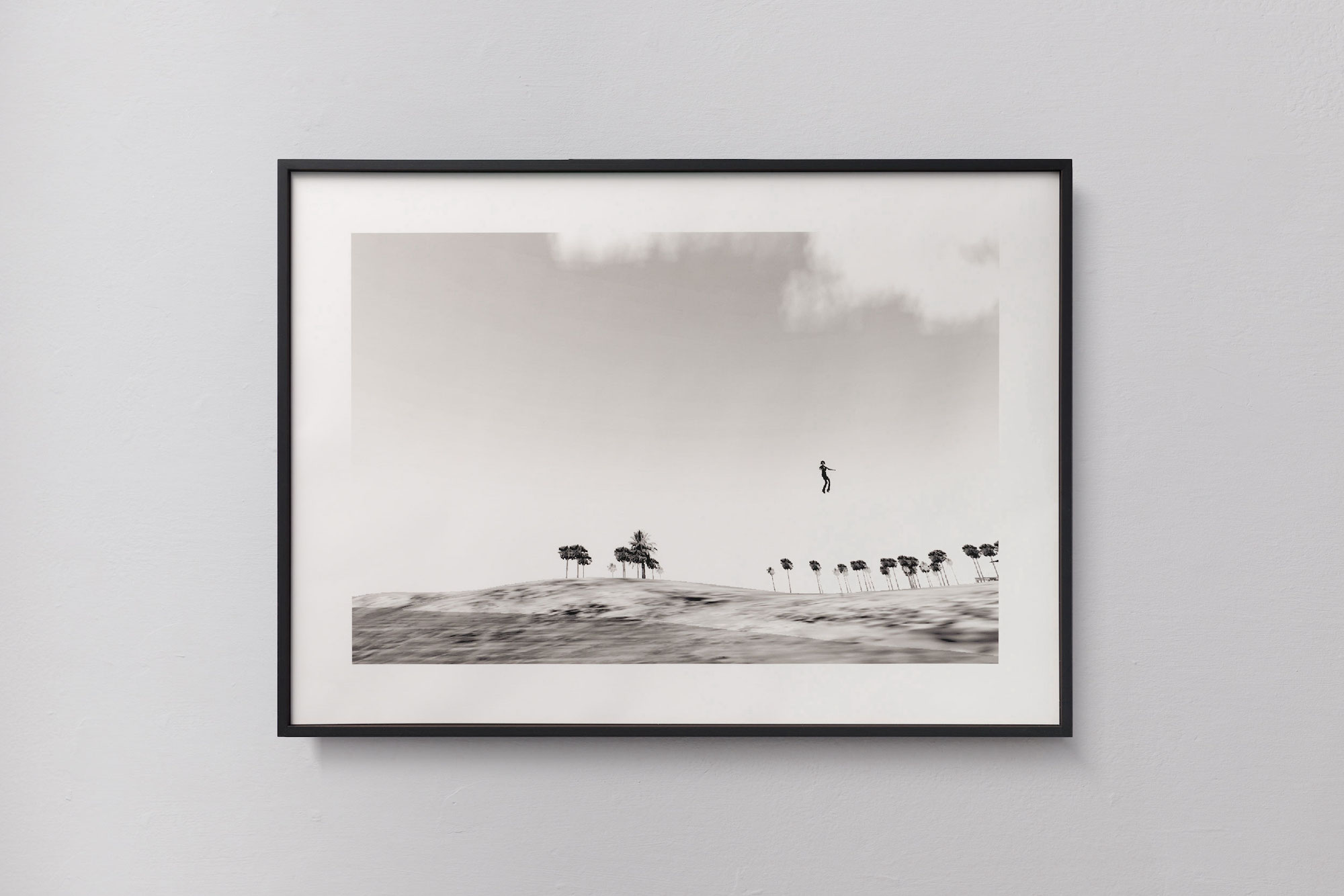
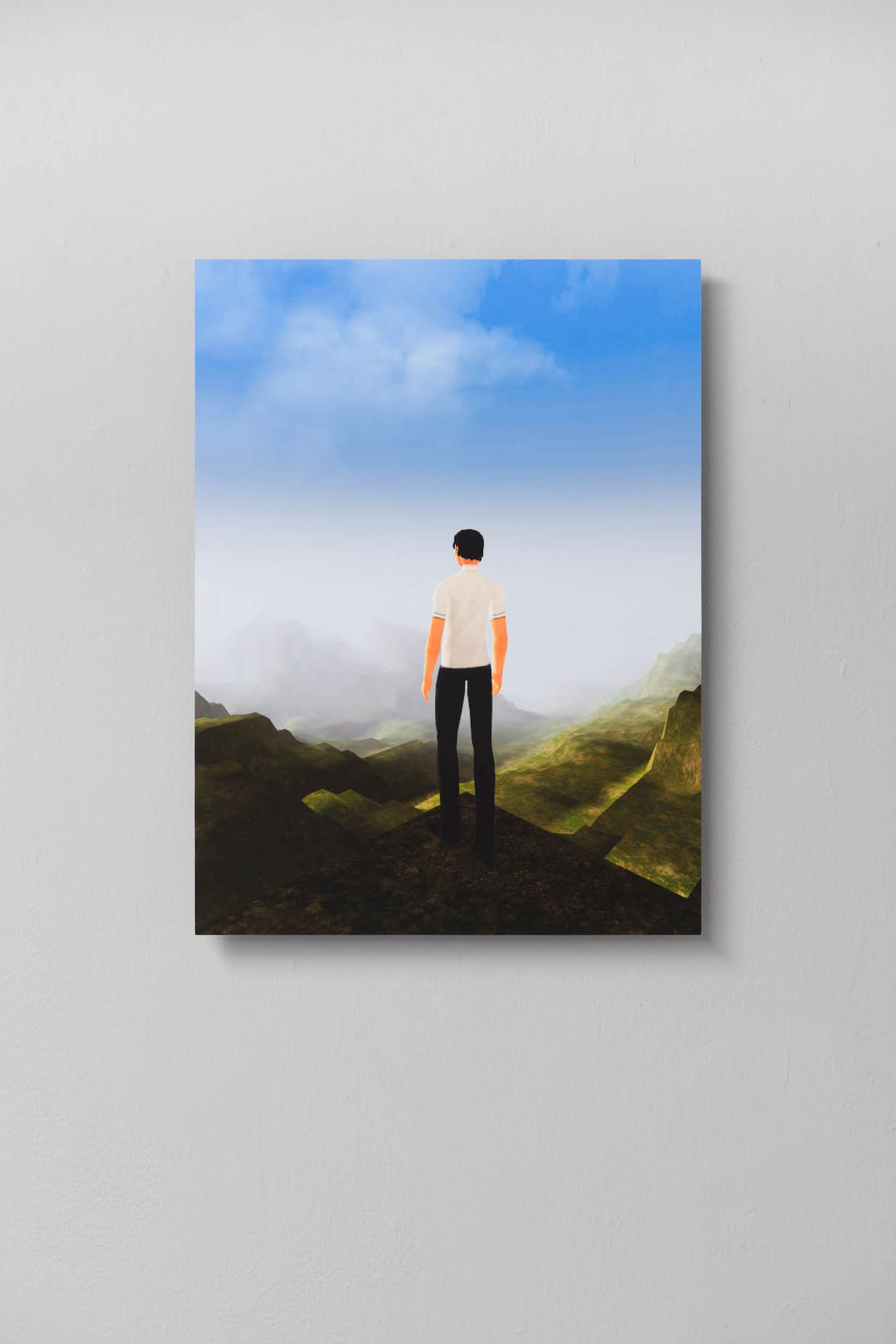
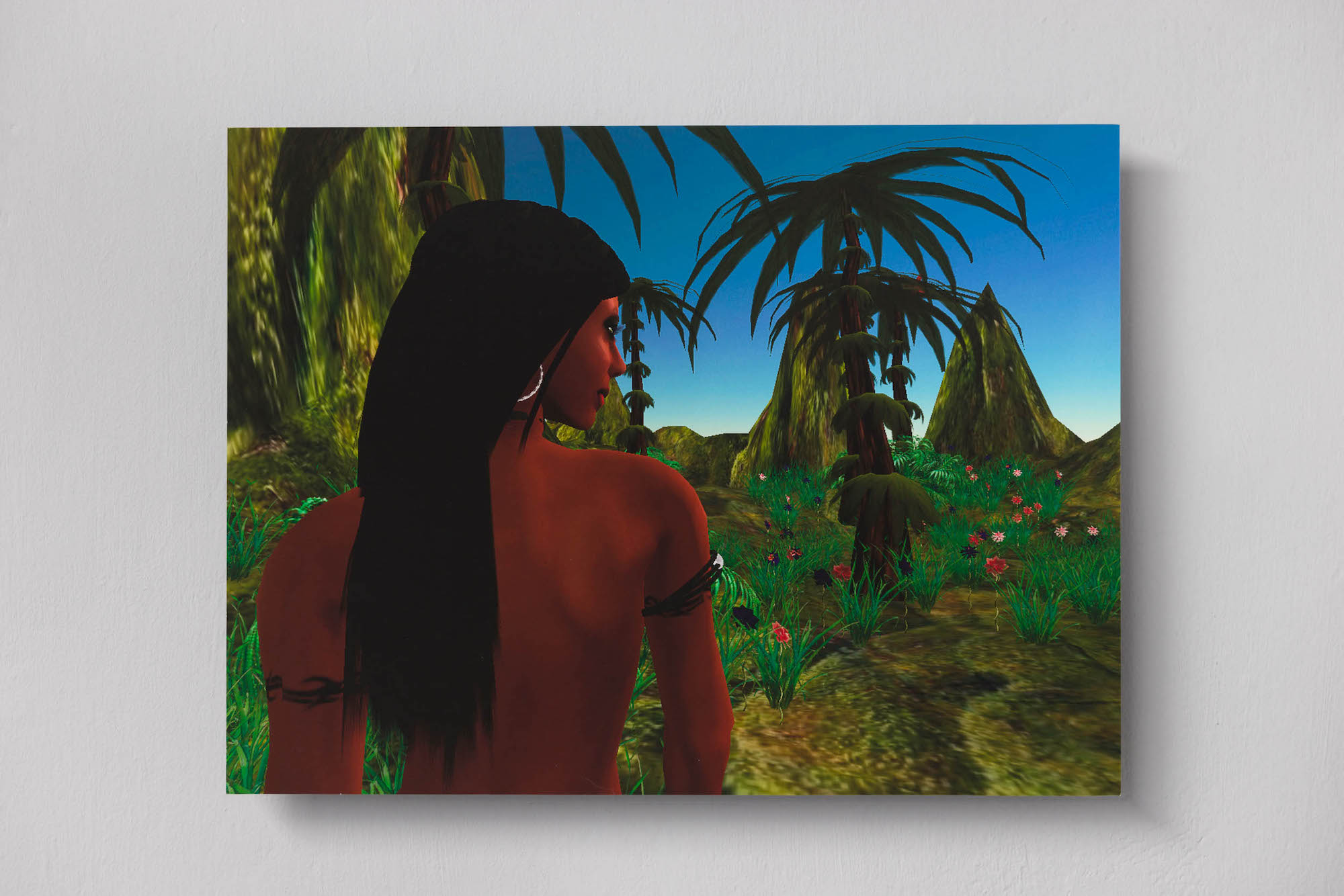
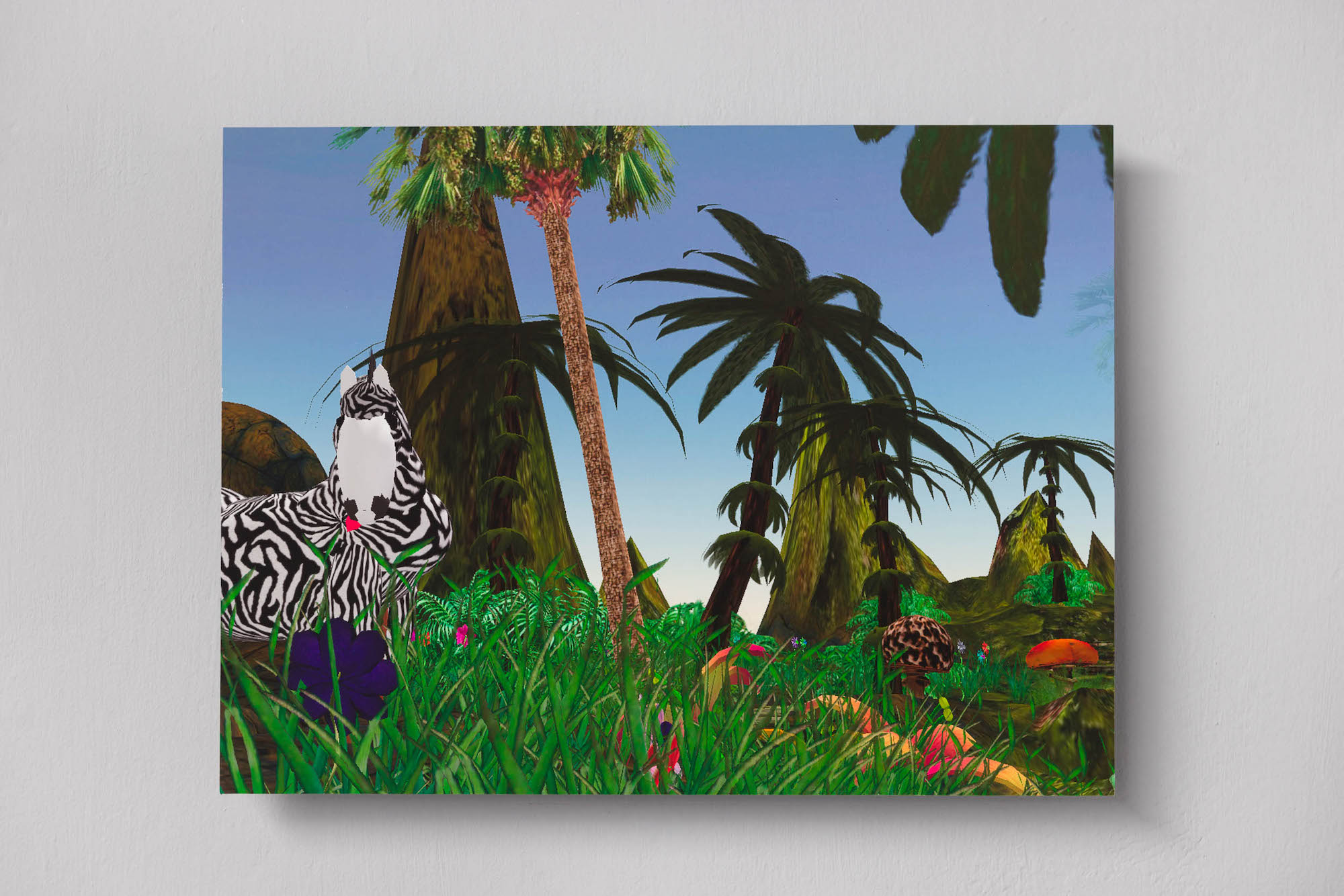
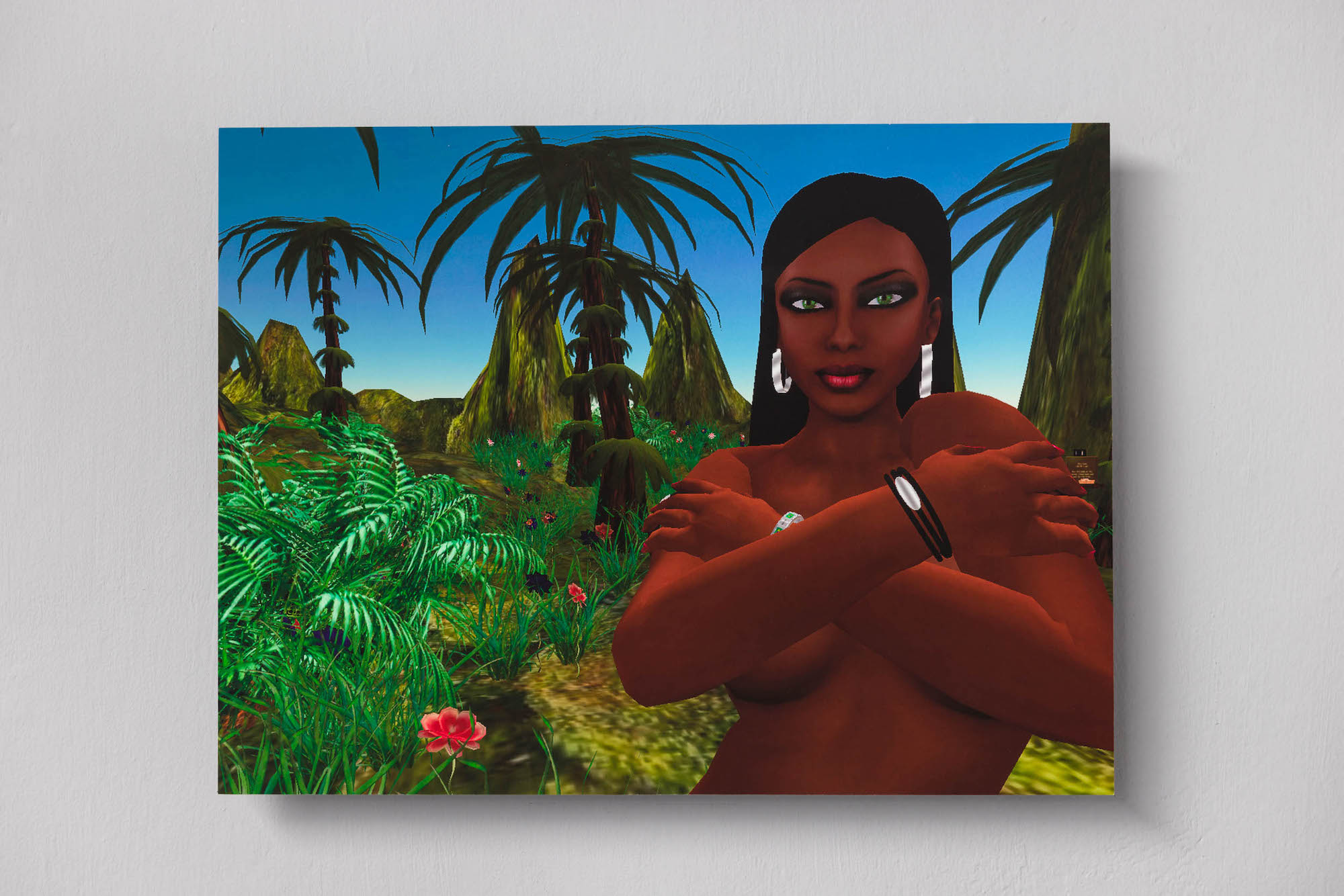

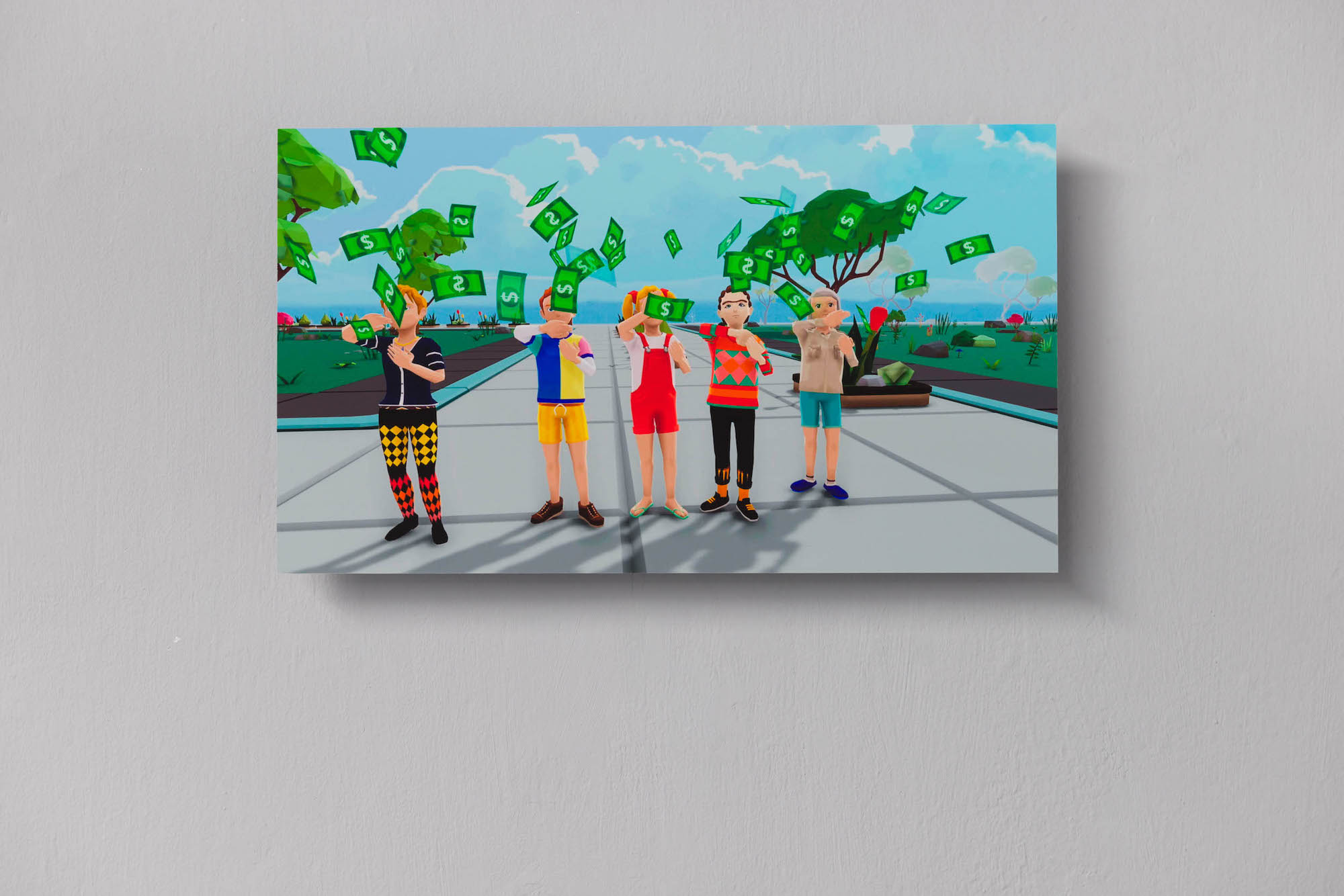
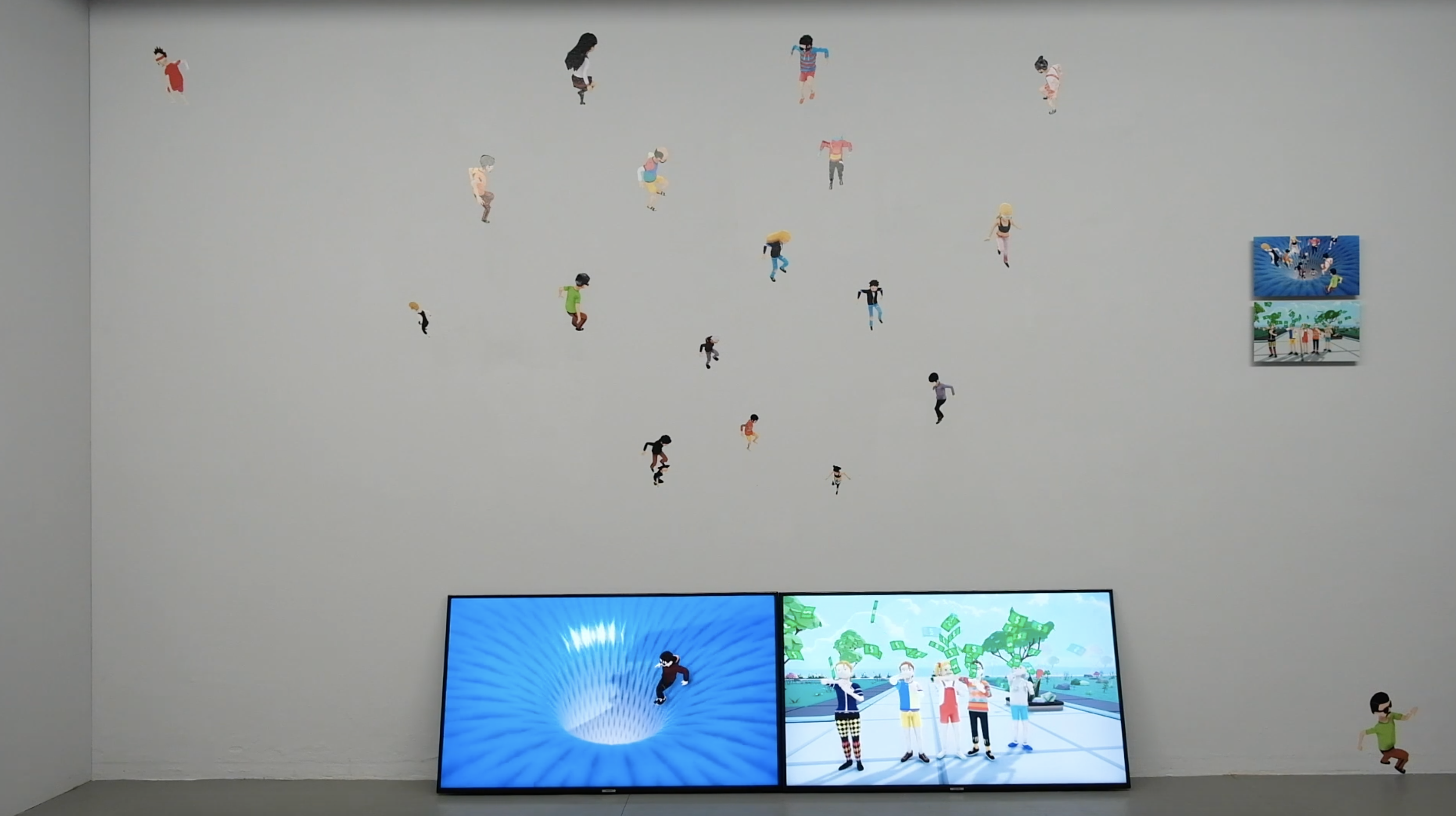

For all SMDOT/contemporary art exhibitions, a playlist will be created by Steve Nardini, the heart and soul of KOBO SHOP and a great musical expert. The following songs and artists have been selected for Marco Cadioli and his solo exhibition "Back to the Metaverse”